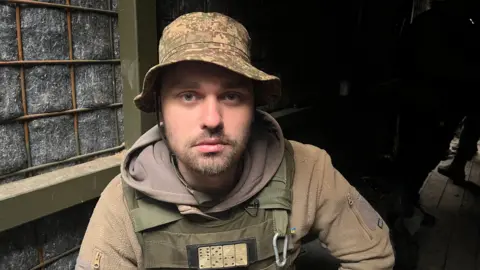On May 8, 2025, Russian President Vladimir Putin announced a three-day ceasefire, timed to coincide with Russia’s Victory Day, commemorating the end of World War II in Europe. However, as the ceasefire commenced, reports from the battlefield indicate that hostilities continued unabated. Journalists traveling through the Donetsk region of eastern Ukraine encountered ongoing military activity rather than the peace that was ostensibly being honored.
A firsthand account revealed continuous explosions and mortar fire, suggesting that the ceasefire had little impact in terms of fostering peace on the frontlines. Soldiers stationed near the fiercely contested city of Pokrovsk voiced skepticism regarding the Russian declaration of a truce. One soldier, Serhii from the 3rd Operational Brigade of the National Guard, stated unequivocally, “There is no truce. We are always prepared for anything.” He reflected on the untrustworthiness of Russian promises, emphasizing that while a ceasefire may be declared, hostilities resume ere long and their forces remain in a constant state of readiness.
The narrative is further complicated by geopolitical considerations. Ukraine’s own President Volodymyr Zelensky dismissed Russia’s unilateral declaration, instead advocating for a more extended truce of 30 days, a proposal that was reiterated by U.S. President Donald Trump via social media. Trump’s increased involvement includes warnings that the U.S. and its allies may impose further sanctions should violations of the ceasefire occur.
As the war drags on, the soldiers on the ground express ambivalence regarding international diplomacy aimed at achieving peace. Among them, Max, a 26-year-old soldier, expressed a belief in “tunnel vision” as a requisite for survival. He candidly remarked, “You don’t think about things like that when you are here,” indicating that concerns about global diplomatic efforts are far removed from the immediate realities of combat.
In Dobropillya, a city situated roughly 12 miles from Russian positions, the droning sounds of explosions haunt the residents, including individuals displaced by the conflict. Svitlana, a woman who relocated from Pokrovsk, articulated her skepticism over the Russian ceasefire, noting, “You can hear the sounds here.” Her words ring true in a locale where sounds reminiscent of rolling thunder are a clear reminder of ongoing violence.
Locals in Dobropillya shared their fears and apprehensions. Oleksandr, a 65-year-old man, recounted how his family experiences heightened tension during periods that fail to deliver on promises of peace. He described a retreat into despair, acknowledging the emotional toll the conflict has taken on his family: “I’m very scared for my family. I’m scared we might be forced to flee our homes,” he confided, tears welling in his eyes. His distress captures the profound anxiety that envelops civilians caught in the crossfire of ongoing hostilities.
This complex tableau reveals a disheartening reality: while political leaders may issue declarations of ceasefire and peace negotiations, the lived experiences of soldiers and civilians reflect a starkly different story marked by fear, distrust, and the unrelenting sound of conflict. The hope for respite is overshadowed by hard-hitting truths underscored by individuals such as Serhii and Oleksandr, who navigate their existence under the constant threat of violence and uncertainty. The refrain “there is no truce” reverberates not just on the battlefield but within the hearts and minds of those yearning for peace amidst chaos.
As the situation continues to evolve under tense circumstances, this narrative underscores the dissonance between political rhetoric and actual conditions on the ground, emphasizing the dire need for genuine negotiations that consider the realities faced by those most affected by the ongoing conflict.



